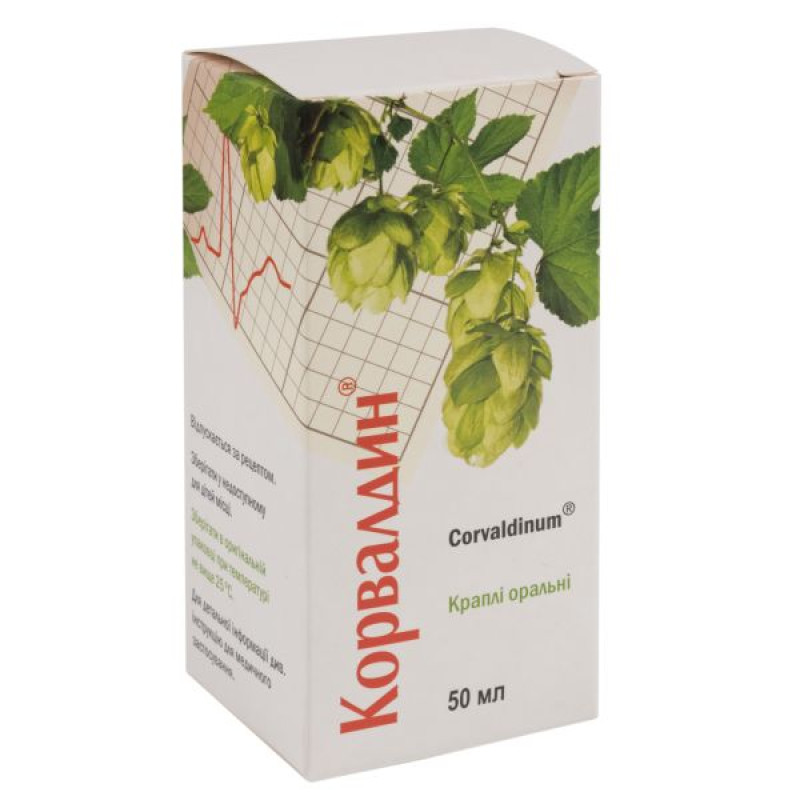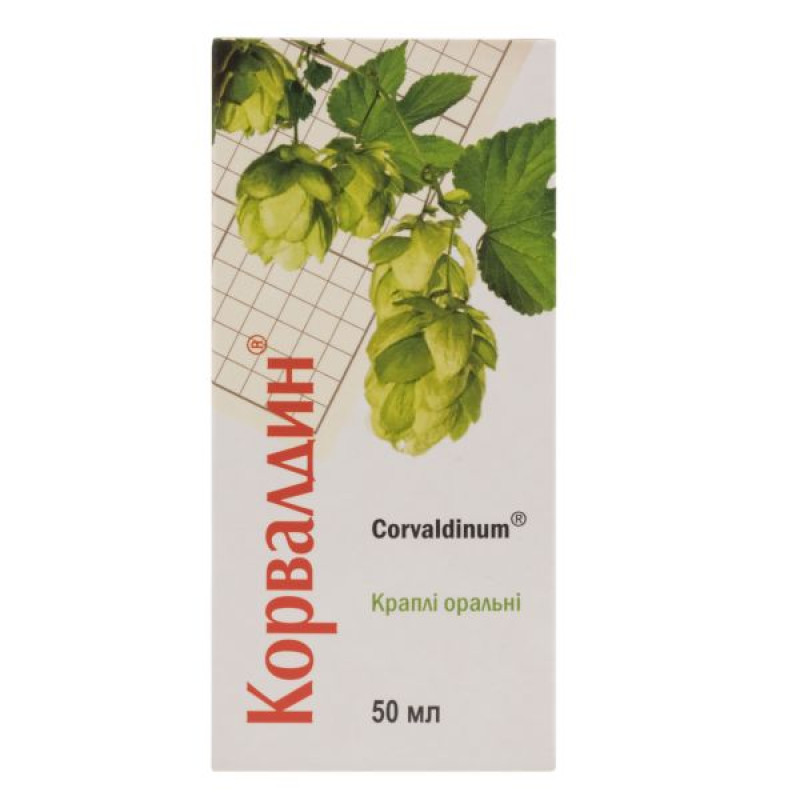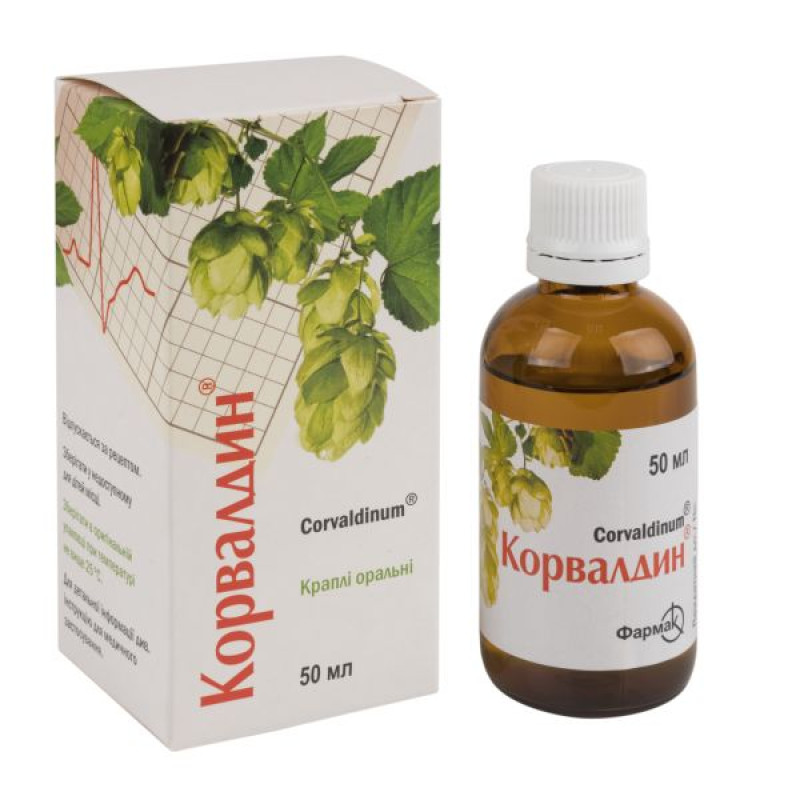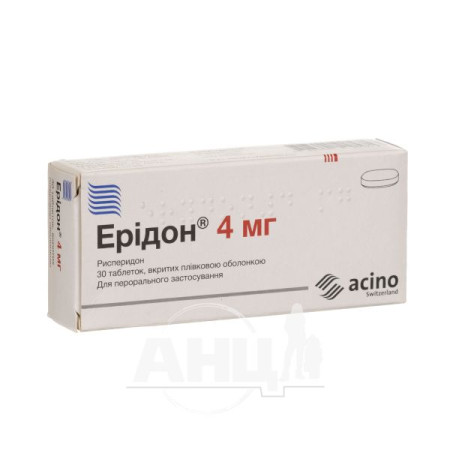Corvaldin oral drops bottle 50 ml

Instructions for use Corvaldin oral drops, 50 ml bottle
Composition
active ingredients: ethyl ester of a-bromoisovaleric acid, phenobarbital, peppermint oil, hop oil;
1 ml of solution (26 drops) contains: ethyl ester of a-bromoisovaleric acid in terms of 100% substance – 20 mg, phenobarbital – 18 mg, peppermint oil – 1.4 mg, hop oil – 0.2 mg;
excipients: stabilizer, ethanol 96%, purified water.
Dosage form
Oral drops.
Main physicochemical properties: clear colorless liquid with a specific odor.
Pharmacotherapeutic group
Hypnotics and sedatives. Barbiturates in combination with other components. ATX code N05C B02.
Pharmacological properties
Pharmacodynamics
Corvaldin is a sedative and antispasmodic drug, the effect of which is determined by the substances that make up its composition.
Ethyl ester of α-bromizovaleric acid has a sedative and antispasmodic effect due to irritation of receptors of the oral cavity and nasopharynx, a decrease in reflex excitability in the central nervous system and increased inhibition in neurons of the cortex and subcortical structures of the brain, as well as a decrease in the activity of vasomotor centers and a direct local antispasmodic effect on vascular smooth muscle.
Phenobarbital inhibits the excitatory effects of the reticular formation centers on the cerebral cortex. Sedative, tranquilizing, or hypnotic effects depend on the dose of the drug.
Peppermint oil and hop oil have a reflex vasodilating and antispasmodic effect, irritating the "cold" receptors of the oral cavity, have a choleretic effect, and eliminate flatulence.
Pharmacokinetics
Phenobarbital is absorbed rapidly (directly in the stomach). Approximately 35% of it binds to plasma proteins, the part that is not bound to proteins is filtered by the kidneys. Reabsorption occurs at a low pH. Reverse diffusion does not occur due to the alkalinity of the urine. Approximately 30% of phenobarbital is excreted unchanged in the urine, and only a small part of it is oxidized in the liver. With prolonged use, there is an accumulation of the active substance in the blood plasma, as well as induction of liver enzymes. As a result of this induction, the oxidation process of phenobarbital and other drugs is accelerated.
Bromine in ethyl bromisovalerianate is slowly excreted from the body. If the drug is used for a long time, its accumulation in the CNS occurs, leading to chronic bromine intoxication.
Indication
neuroses with increased irritability; insomnia; in the complex therapy of hypertension and vegetative-vascular dystonia; mild coronary spasms, tachycardia; intestinal spasms caused by neurovegetative disorders (as an antispasmodic drug).
Contraindication
Hypersensitivity to the active substances or to any other component of the drug, bromine; acute hepatic porphyria; severe liver and kidney dysfunction; diabetes mellitus, myasthenia gravis. Medicines containing phenobarbital are contraindicated in alcoholism, drug and drug addiction (including a history); in respiratory diseases with shortness of breath, obstructive syndrome, severe arterial hypotension, in acute myocardial infarction; in depression and depressive disorders with a tendency of the patient to suicidal behavior.
Interaction with other medicinal products and other types of interactions
When using the drug with other drugs that depress the central nervous system, mutual enhancement of the effect (sedative-hypnotic effect) is possible, which may be accompanied by respiratory depression. Alcohol enhances the effect of the drug and may increase its toxicity.
Medicines containing valproic acid enhance the effects of barbiturates.
Phenobarbital induces liver enzymes and, thus, can accelerate the metabolism of some drugs that are metabolized by liver enzymes (for example, coumarin derivatives, antibiotics, sulfonamides, antivirals, oral hypoglycemic, hormonal, immunosuppressive, cytostatic, antiarrhythmic, antihypertensive drugs). Phenobarbital enhances the effect of analgesics, anesthetics, anesthetics, neuroleptics, tranquilizers; reduces the effect of paracetamol, indirect anticoagulants, metronidazole, tricyclic antidepressants, salicylates, cardiac glycosides.
The drug increases the toxicity of methotrexate.
Application features
During treatment with the drug, it is not recommended to engage in activities that require increased attention, rapid mental and motor reactions.
Simultaneous consumption of alcoholic beverages should be avoided.
Life-threatening skin reactions such as Stevens-Johnson syndrome and toxic epidermal necrolysis have been reported with the use of phenobarbital.
Patients should be advised of the signs and symptoms and monitored closely for skin reactions. The highest risk of Stevens-Johnson syndrome or toxic epidermal necrolysis is during the first weeks of treatment.
If symptoms of Stevens-Johnson syndrome or toxic epidermal necrolysis (e.g. progressive skin rash, often with blisters, and mucosal lesions) occur, treatment should be discontinued.
The best results in the treatment of Stevens–Johnson syndrome or toxic epidermal necrolysis have been observed with early diagnosis and immediate discontinuation of any suspected drug. The best prognosis in treatment is associated with early discontinuation of the suspected drug.
If a patient develops Stevens-Johnson syndrome or toxic epidermal necrolysis while using Corvaldin®, the drug should never be used in these patients again.
If the pain in the heart area does not go away after taking the drug, you should consult a doctor to rule out acute coronary syndrome. It is prescribed with caution in hyperkinesias, hyperthyroidism, adrenal hypofunction, decompensated heart failure, arterial hypotension, constant pain, acute drug intoxication.
This medicine contains 60% by volume of ethanol (alcohol).
The minimum dose of the drug (15 drops) contains 271 mg of ethanol, which is equivalent to 6.9 ml of beer or 2.9 ml of wine. Harmful for patients suffering from alcoholism. Caution should be exercised when using in patients with liver disease and epilepsy.
Long-term use is not recommended due to the risk of developing drug dependence, possible accumulation of bromine in the body, and the development of bromine poisoning.
Ability to influence reaction speed when driving vehicles or other mechanisms
Corvaldin contains phenobarbital and ethanol, therefore it may cause impaired coordination, psychomotor speed, drowsiness and dizziness during treatment. In this regard, it is not recommended to engage in activities that require increased attention, including driving and working with other mechanisms.
Use during pregnancy or breastfeeding
Do not use during pregnancy or breastfeeding.
Method of administration and doses
Take 15–30 drops orally before meals with a small amount (30–50 ml) of liquid 2–3 times a day. A single dose can be increased to 40–50 drops if necessary.
The duration of use of the drug is determined by the doctor depending on the clinical effect and tolerability of the drug.
Children
There is no experience in the treatment of children, therefore the drug should not be used in pediatric practice.
Overdose
Symptoms.
Acute (mild to moderate) barbiturate poisoning:
dizziness, fatigue, even a deep sleep from which the patient cannot be awakened.
Hypersensitivity reactions may occur: angioedema, urticaria, itching, rash.
Acute severe poisoning:
deep coma accompanied by tissue hypoxia, shallow breathing, first rapid, then slow breathing, rapid heartbeat, cardiac arrhythmia, low blood pressure, bradycardia, vascular collapse, weakening or loss of reflexes, nystagmus, headache, nausea, weakness, cardiac dysfunction, decreased body temperature, slowed pulse, decreased diuresis.
If poisoning is left untreated, death is possible as a result of vascular insufficiency, respiratory paralysis, or pulmonary edema.
Overdose is possible with long-term use of the drug, which is associated with the cumulation of its components. Long-term and constant use can cause addiction, withdrawal syndrome, and psychomotor agitation.
Prolonged use of bromine-containing drugs can lead to bromine poisoning, which is characterized by the following symptoms: a state of confusion, ataxia, apathy, depressed mood, conjunctivitis, colds, acne, or purpura.
Treatment.
Treatment of bromine poisoning: the elimination of bromine ions from the body can be accelerated by administering a significant amount of table salt solution with the simultaneous administration of saluretics.
If hypersensitivity reactions occur, prescribe desensitizing medications.
Adverse reactions
Nervous system: asthenia, weakness, impaired coordination of movements, nystagmus, ataxia, hallucinations, paradoxical excitement, insomnia (in elderly patients), decreased concentration, fatigue, slowed reactions, headache, cognitive disorders. In some cases, drowsiness and mild dizziness, confusion may occur.
Musculoskeletal: With prolonged use of drugs containing phenobarbital, there is a risk of impaired osteogenesis. There have been reports of reduced bone mineral density, osteopenia, osteoporosis, and fractures in patients receiving long-term therapy with phenobarbital. The mechanism by which phenobarbital affects bone metabolism has not been identified.
On the part of the digestive tract: nausea, vomiting, constipation, heaviness in the epigastric region, with prolonged use - impaired liver function.
From the side of the hematopoietic system: agranulocytosis, megaloblastic anemia, thrombocytopenia, anemia.
From the cardiovascular system: decreased blood pressure, bradycardia.
Skin and mucous membranes: Stevens-Johnson syndrome, toxic epidermal necrolysis, allergic reactions, including rash, itching, urticaria.
Immune system disorders: hypersensitivity reactions, including angioedema, difficulty breathing, facial swelling.
Prolonged use of bromine-containing drugs can lead to bromine poisoning, which is characterized by the following symptoms: central nervous system depression, depression, confusion, ataxia, apathy, conjunctivitis, rhinitis, lacrimation, acne, or purpura.
Expiration date
3 years.
Do not use the drug after the expiration date indicated on the package.
Storage conditions
Store in original packaging at a temperature not exceeding 25 ° C. Keep out of the reach of children.
Packaging
50 ml in a bottle, 1 bottle in a pack.
Vacation category
According to the recipe.
Producer
JSC "Farmak".
Location of the manufacturer and its business address
Ukraine, 04080, Kyiv, Kyrylivska St., 74.
There are no reviews for this product.
There are no reviews for this product, be the first to leave your review.
No questions about this product, be the first and ask your question.















